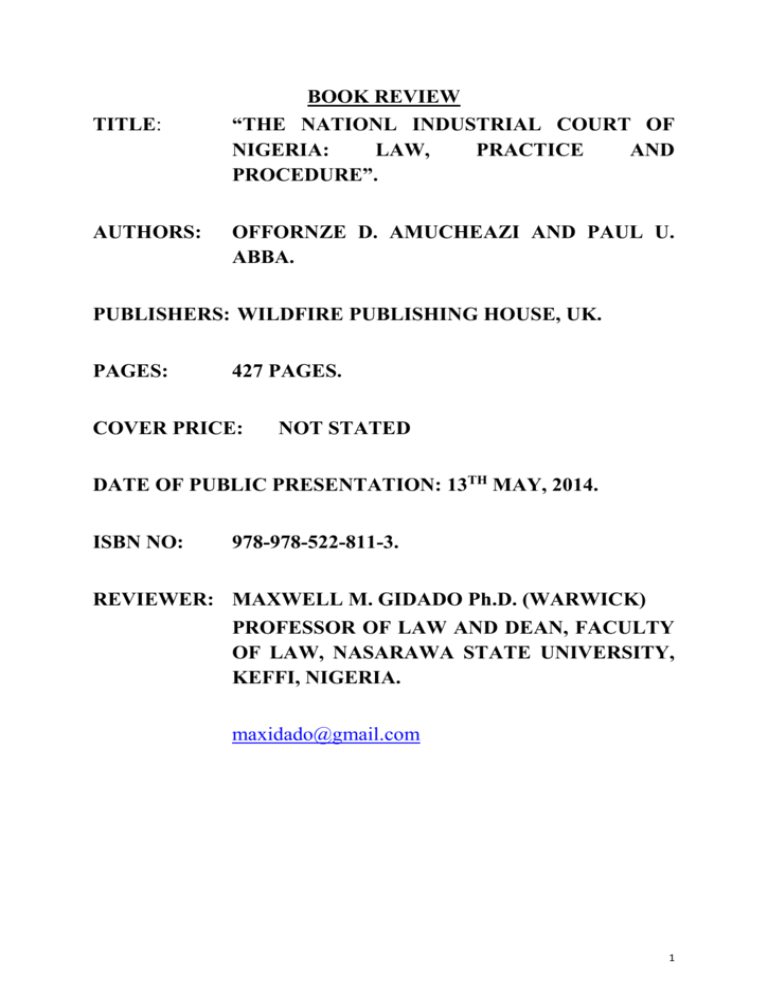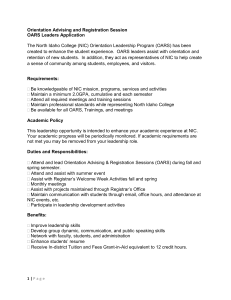Click here to Review Document.
advertisement

TITLE: AUTHORS: BOOK REVIEW “THE NATIONL INDUSTRIAL COURT OF NIGERIA: LAW, PRACTICE AND PROCEDURE”. OFFORNZE D. AMUCHEAZI AND PAUL U. ABBA. PUBLISHERS: WILDFIRE PUBLISHING HOUSE, UK. PAGES: 427 PAGES. COVER PRICE: NOT STATED DATE OF PUBLIC PRESENTATION: 13TH MAY, 2014. ISBN NO: 978-978-522-811-3. REVIEWER: MAXWELL M. GIDADO Ph.D. (WARWICK) PROFESSOR OF LAW AND DEAN, FACULTY OF LAW, NASARAWA STATE UNIVERSITY, KEFFI, NIGERIA. maxidado@gmail.com 1 The book we are all witnesses to its presentation to the public is entitled: “THE NATIONAL INDUSTRIAL COURT OF NIGERIA: LAW, PRACTICE AND PROCEDURE”. It is written by 2 highly intelligent and resourceful authors - Prof. Offornze D. Amucheazi and Paul U. Abba Esq. The book is designed to discuss fundamental issues relating to the jurisdiction of the National Industrial Court and analyzes practice and procedures of the court in adjudicating matters before it. The enactment of the Constitution of the Federal Republic of Nigeria (Third Alteration) Act 2010 marked a watershed moment in the resolution of labour and employment disputes in Nigeria because it brought about immeasurable advancement in the jurisdiction and powers of the National Industrial Court (NIC). The Third Alteration Act not only resolved the constitutional “sludge” surrounding the jurisdiction and status of the NIC as a superior court of record, it also established the NIC as the prime and exclusive judicial body for the resolution of all labour, employment and industrial relations affairs in the country, and this has produced significant results in the field of industrial relations with respect to constantly arising exoteric disputes. Before I examine the book chapter by chapter, let me preface this book review also by stating that I recognize the fact that a book review is not supposed to be verbose as to serve as a replacement to a copy of the book but a graphic summary of the book, sufficient enough to stir up your appetite and provoke a desire in you to get a copy or copies of the book as soon as possible after the public presentation. I also realize that brevity is the portrait of wisdom. Saying too much can actually show a lack of knowledge of the issues involved. For it is not in much speaking or talking that the truth is told, so I shall therefore be brief in my review. 2 STRUCTURE OF THE BOOK: The book is published by Wildfire Publishing House, U.K. and printed and bound in U.K. by Wildfire Publishing House. In all, the book has 15 Chapters, appendices, bibliography, table of cases, table of statutes and index all housed in 427 pages. The book is an assemblage of a very richly researched work which was resourcefully written by a team of these learned authors – a Learned Professor and a renowned legal mind. I commend the authors for the painstaking and diligent research that they have put into this monumental work. The industry put into the making of this book caught the admiration of the President, National Industrial Court of Nigeria, Abuja – Hon. Justice Babatunde A. Adejumo who rightfully stated in his foreword to the book as follows; “This book is a pioneering and excellent work on the jurisdiction, practice and procedures of the NIC and an in-depth appraisal of fundamental issues surrounding the judicial powers of the court. The authors have proficiently analyzed topical issues relating to the court such as the jurisdictional scope of the court, transfer of cases from the High Courts to the court, right of appeal from decisions of the court, power of judicial review of the court and enforcement of the judgments and orders of the court”. He went further to say that; “It fills a gap in knowledge regarding the constitutional empowerment of the court by Section 254C (2) of the 1999 Constitution (as amended) which 3 is of immense importance to lawyers and litigants appearing before the court”. I agree no less with my Lord the Honourable Justice Adejumo’s observation as in my view, the book is timely, published at a time when the NIC is undergoing significant reforms to enable it efficiently to accomplish its constitutional responsibility in ensuring the enthronement of good and best international labour practices in Nigerian labour law. The exposition of the practice and procedure of the court in this book will enlighten lawyers and litigants on the procedures for ventilation of labour rights before the court and ensure smooth handling of cases before it. What follows therefore is a synopsis of the book on a thematic basis. CHAPTER 1 INTRODUCTION, HISTORY AND DEVELOPMENT OF THE NIC OF NIGERIA:This chapter which is introductory chronicles the history and development of the NIC since its birth in 1976 and examines the various stages of its evolution through the decades, up to the period of its maturity and constitutionalization in March 2011, which has been heralded as a watershed in the history of the NIC and the high-water mark in the adjudication of labour disputes in Nigeria. The chapter also highlights important developmental stages in trade disputes adjudication in Nigeria and discusses the shift from a noninterventionist approach to an interventionist approach in labour disputes resolution. The current interventionist approach is marked by industrial arbitration tribunals, awards, reference of trade disputes by the Minister and adjudication by the NIC as the apex court in resolution of labour disputes. 4 CHAPTER 2 JURISDICTION OF THE NIC:This chapter is devoted to an in-depth analysis of the jurisdictional sphere of influence of the NIC, as currently provided under the 1999 Constitution (as amended). In this respect, three major forms of jurisdiction of the NIC are discussed herein, to wit: a. Civil and Criminal Jurisdiction b. Original and Appellate Jurisdiction, and c. Territorial Jurisdiction. I have deliberately left out discussing details of these in this review so as to trigger your anxiety to know. This you will find at pages 66 to 94 of the book. In view of the close interrelationship between the jurisdiction and judicial powers of a court, the judicial powers of the NIC under extant law are discussed alongside its jurisdiction under the Constitution. Issues surrounding the invocation of the NIC’s jurisdiction in cases of principal and ancillary reliefs are also discussed. CHAPTER 3 MEMBERSHIP, COMPOSITION AND APPOINTMENT OF JUDGES OF THE NIC:This chapter examines various aspects of the composition of the NIC including the appointment and removal of its President and judges, administrative decisions, assignment and distribution of cases and sittings of the court. The number of judges of the NIC is specified in Section 254A of the 1999 Constitution (as amended) to be; a) The President of the NIC and b) Such number of Judges of the NIC as may be prescribed by an Act of the National Assembly. Thus, the NIC Act 2006 stipulates that the NIC shall be composed of not less than 12 5 judges in addition to the President of NIC, who shall have overall control and supervision of the administration of the court. For more on this, see pages 95 to 105 of the book. CHAPTER 4 INSTITUTION OF CIVIL SUITS:Chapter 4 is concerned with the mode of institution of civil suits in the court, filling and issuing of originating processes and effects of non-compliance, including provision of the rules on commencement of actions at the NIC. In exercising its civil jurisdiction, the practices and procedures adopted at the NIC in respect of institution, commencement and trial of suits are akin, in most respects to those of the State High Courts with relevant modifications to accommodate the peculiarities of the NIC’s jurisdictional scope over labour and employment matters. CHAPTER 5 SERVICE OF ORIGINATING PROCESSES AND APPEARANCE:Chapter 5 dwells on the manner of service of originating processes, the knotty issues of service out of jurisdiction, default of appearance and filling of defence by parties. This chapter will be useful to the legal practitioners in the field of industrial or labour matters. For further reading on this refer to pages 127 to 145 of the book. CHAPTER 6 MOTIONS AND INTERLOCUTORY APPLICATIONS:- 6 This chapter focuses on motions and interlocutory applications before the court and powers of the court to grant injunctions and other interim relief in matters before it. For more on this very key and important subject of MOTIONS AND INTERLOCUTORY APPLICATIONS, see the book under review at pages 146 to 166. CHAPTER 7 SUMMARY JUDGMENT PROCEDURE:Chapter 7 contains summary judgment procedure at the NIC and the effect of a judgment obtained under such procedure. This is found on pages 167 to 176 of the book. CHAPTER 8 TRIAL AND PRESENTATION CASES:In Chapter 8, attention is focused on the issues relating to the procedure for trial and presentation of cases at the NIC, visits to locus in quo by the court, filling of written addresses and discontinuance of cases by parties. Referral of cases to alternative dispute resolution by the court, and the procedure and effect of decisions of an arbitrator or special referee appointed by the court are also discussed. CHAPTER 9 JUDGMENT AND ENFORCEMENT:Chapter 9 centers on deliverance of judgments by the court and modes of enforcement of judgments and orders of the court under applicable laws. Judgments and orders of the NIC in the context of this chapter refer to judgments given in its original and appellate 7 jurisdiction and extend to every order of the court, whether final or interlocutory. For more on this, see pages 205 to 220 of the book. CHAPTER 10 JUDICIAL REVIEW:Chapter 10 hinges on the procedure for judicial review before the National Industrial Court and analyzes the extant powers of the court to issue prerogative writs under constitutional and statutory provisions. CHAPTER 11 APPEALS:This chapter expounds on appeals from decisions of the NIC and the related issue of cases stated and reference of questions of law to the Court of Appeal under the Constitution. CHAPTER 12 CONTEMPT OF COURT:Chapter 12 deals with contempt of court and procedures for committal for contempt by the court, for both civil and criminal contempt. CHAPTER 13 MISCELLANEOUS MATTERS:Chapter 13 contains the general provisions of the NIC Rules in respect of proceedings before the court. For more on this, see pages 274 to 283 of the book. 8 CHAPTER 14 APPLICATION OF INTERNATIONAL LABOUR CONVENTIONS IN NIGERIA:This chapter discusses an essential aspect of the NIC’s jurisdiction and powers under the 1999 Constitution (as amended), i.e. the application of ratified International Labour Organization conventions by the court. The sources of international labour laws and application of international best practices in labour jurisprudence are also discussed in this chapter. The Learned authors also analyzed some of the obstacles hindering the effective application of international labour principles in labour jurisprudence in Nigeria. CHAPTER 15: INNOVATIONS, CHALLENGES AND RECOMMENDATIONS:This concluding chapter highlights and briefly analyzes some of the innovations introduced by the NIC Act 2006 and the Third Alteration to the 1999 Constitution as these relate to the expansive jurisdiction and powers of the NIC. The challenges facing the court in the exercise of its jurisdiction are also discussed and recommendations are made ensuring the effectiveness of the court in the adjudication of labour and employment disputes in Nigeria. APPENDICES At the end of Chapter 15 the book contains some appendices which include the following: 9 Appendix 1 - Constitution of the Federal Republic of Nigeria (Third Alteration) Act 2010. Appendix 2 - National Industrial Court Act 2006. Appendix 3 - National Industrial Court Rules 2007. Appendix 4 - National Industrial Court Practice Directions 2012. Appendix 5 - General Form of Complaint. Appendix 6 - Chief Registrar’s Certificate. Appendix 7 - ILO Conventions Ratified by Nigeria. Appendix 8 - Text of Fundamental ILO Conventions. Appendix 9 - Judicial Divisions of the NIC. CONCLUSION Although emphasis in this work is placed on decisions of the NIC in respect of the issues discussed, it has taken care to refer to relevant decisions of the regular courts as they affect the issues under discussion, in addition to their impact on the development of a unique labour jurisprudence by the NIC. While the National Industrial Court is bound by the doctrine of judicial precedent to follow the decisions of superior courts on settled principles of law, the court has over the years gradually built up a parallel labour jurisprudence applicable to matters before it and, where necessary, has departed from general principles of common law in labour matters that undermine the labour rights of parties appearing before the court in a bid to conform labour practice in Nigeria to international best practices. 10 After a careful and dispassionate study of the book I am fully persuaded that it represents a sound demonstration of high standard of legal research and erudition. The Learned authors have presented us with a provocative series of analysis which together provide a working blueprint for law’s engagement in the critical areas examined in the book. The end product of course, is a timely innovative and insightful work of very high academic quality that is conceptually and empirically rich and well researched. Accordingly, I have no hesitation in recommending this book as a working companion to practitioners in the labour and employment industry – i.e. employers, employees and trade unionists – to Law Teachers and students of labour law and researchers, legal practitioners and jurists. I hope that this book will prove to be of significance to all categories of readers and help to expand knowledge in respect of the practice and procedures of the NIC, a unique court in the annals of judicial history in Nigeria. Thank you for your kind attention. God bless. 11








